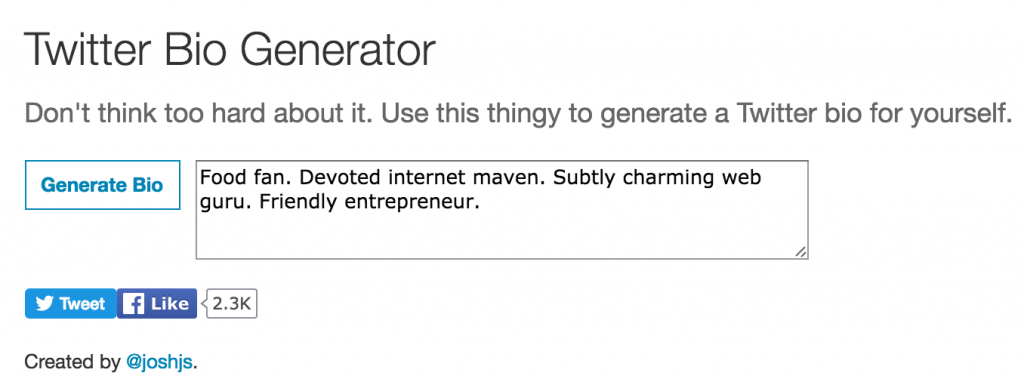
How to Craft an Awesome Twitter Bio
Remember: your bio is usually the first thing people see when deciding whether to follow you on social media. Like it or not, it’s your elevator pitch that is immediately judged by what you write in your bio.
This post is the fourth in our series on how to write impressive bios for social media. To catch up, here are our first three:
✓Blog: 9 Steps to Write a Killer ‘About Me’ Blog Author Bio that Doesn’t Suck
✓Facebook: Facebook Bio Examples – Ideas to Create a Cool Bio
✓Instagram: How to Create Good Instagram Bios: The Ultimate Checklist
Twitter bios are one of the most important parts of your social media presence. They serve as your online identity and provide a window into your personality. If done well, they can make or break how people perceive you.
In this article, we’ll cover some tips and ideas about your perfect Twitter bio ideas. We’ll also include examples of Twitter bios written by real brands.
Whether you’re treating it earnestly, opportunistically, or as a complete joke, your Twitter bio is your elevator pitch for who you are. – Lara Cohen, Twitter’s head of entertainment talent and lifestyle partnerships.
What is a Powerful Twitter Bio?
A good Twitter bio should tell someone who you are, and what your job is, and give them some relevant content to read. You don’t need to say everything about yourself, just enough to make people interested in knowing more.
Don’t forget to include an avatar picture if you want to stand apart from the crowd. An image helps people remember you better and makes them feel like they know you already.
Use emojis to express how you’re feeling. These little icons help convey emotion and show others what you mean without having to type long sentences.
Avoid using common words in your Twitter bios. Instead, use short phrases and simple language.
Consider using a Twitter Bio generator to find some inspiration. There are tons of tools online that will generate random Twitter bios for you based on the keywords you enter. Some even allow you to add images to your profile.
A good Twitter biography should tell people who you are without being too wordy. You only get a limited character amount to describe yourself, so make sure you’re concise and clear. Try not to include any unnecessary information such as links to your website or social media profiles.
Some business owners want their bios to be personal and to describe themselves and what they do. Some people prefer it when it’s funny and quirky. Whatever your ideal bio might look like, you need to think carefully about writing it down.
Avoid Obvious and Overused Buzzwords
Buzzword usage is ubiquitous. You’ll find them in advertisements, tweets, blogs, and even some news stories. Some people utilize buzzword usage because it makes them sound more intelligent and are very current with business trends. Other people utilize them because they realize that’s what everybody else does. And yet others simply enjoy throwing around meaningless jargon because they believe it makes them sound cooler and more professional and “hip”.
Using terms like “Lean Startup” or “Agile Marketing” doesn’t make you sound smarter than someone who calls themselves a “marketing expert.” It’s just a meaningless label. If you want to sound unique, write something like “I am an expert at B2B Software Technology Marketing”.
If you tell someone that you’re a “growth hacker” they probably won’t understand exactly what you’re talking about unless they are a marketer like you, and they are not to be considered potential clients or prospective followers. Someone might even assume you mean computer hacking – someone who breaks into company networks to steal information. Let your potential clients or customers know what you can do for them.
Powerful Twitter Bio Ideas
Compelling Twitter bios have made online conversations between people feel like real life conversations with thousands of active participants.
To write a good tweet, you need to put the right words in the correct order. To write a good Twitter post, you must arrange the words correctly. You only have so many characters available. Writing a compelling Twitter bio will increase your chances of attracting new followers. It’s harder when you have just a 160 character limit to display your entire brand identity to your Twitter audience.
Amazing Twitter Bio Examples:
1 – The Fuzzy Family Bio
Used by: Politicians, Public Figures, VIP’s
What it means: You’re a VIP and have no need to introduce yourself. Putting family first “is a way of politicians and public figures humanizing themselves,” says Cohen. “It makes these massively public, superhuman figures seem approachable, which is what Twitter does for public figures.”
For example, on Twitter, President Obama puts family first: “Dad, husband, and 44th President of the United States.”
2 – The Résumé
Used by: Writers/Content Creators, Professionals, and those using Twitter as a venue for self-promotion
What it means: You’re hustling—and, according to Cohen, there’s no shame in that. “For the real people among us, especially someone like you who is a writer and is putting your work out there, people use Twitter and, by extension, their Twitter bio to announce who they are in this very public universe.”
3 – The Autobiography
Used by: CEO’s, Business Owners, Entrepreneurs
What it means: You hardly ever sleep. This Twitter bio art form, tweeters tell their life story in the space of 160 characters.
4 – The Minimalist
Used by: Celebrities, Comedians, some of Twitter’s most popular kids
What it means: You’re “untouchably” cool, and everyone wants to be you. Bonus points when your minimal bio also happens to be funny. According to Cohen: “Announcing that you have a sense of humor about yourself as a celebrity is a good look.”
5 – The Disclaimer
Used by: Considerate tweeters who have a way of warning about their tendencies, like a political reporter warning about her numerous Red Sox tweets. Bio disclaimers can also come from a place of self-preservation: Shonda Rhimes tells her 1.2 million followers: “I make stuff up for a living. It’s not real, okay? Don’t tweet me your craziness.”
What it means: You have a considerable following and impeccable online etiquette, and you’d rather not weather the backlash when you tweet obsessively about something.
First Step: Figure Out How You are Going to Stand Out.
A good bio has a mix of a profession as well as personal. Share something that will connect you with your audience.
Mix parts of #1 – You as a real person (use your true identity/profession): Chef, Journalist, CEO, Student, Artist, Lifestyle Coach
Mix parts of #2 – Your personality: Coffee snob, surfer, yoga lover, fitness guru, backyard chicken farmer, chief cook and bottle washer, Dad, Minecraft geek.
The key is to find the right balance between personal and professional. The professional side gives your credentials while the personality side shows an insight into who you are as a human being. It gives potential followers something they can latch on to talk to you about.- – they are both relevant pieces of content.
Introduce Yourself
Your bio is one of the most important parts of your online presence. It tells potential customers what you do, how long you’ve been doing it, and why they should care.
In fact, according to HubSpot research, a well-written bio is one of the best ways to convert visitors into leads.
Introduce yourself to potential followers by explaining what you do. You may want to include a short paragraph describing your business, share some key qualities about your company, or let people know what to look forward to if they follow you.
Here are Some Tips to Make Sure Yours Stands Out:
1. Keep it brief. You’re trying to convey information quickly, so keep it to three paragraphs max. If you go over four, consider breaking it up into multiple sections.
2. Make it personal. People want to know who you are and why you’re worth reading. Don’t just list off your job title. Instead, tell stories about how you got where you are today, and what you see as your mission in life. Include examples of projects you worked on and awards you won. This helps humanize you and makes readers feel like you’re talking directly to them.
3. Focus on skills and accomplishments. When writing your bio, focus on what you offer and what sets you apart from others. For example, if you’re a web developer, talk about your work experience and mention the specific technologies you use. Or if you’re a writer, highlight your published works.
4. Be honest. If you don’t believe something you wrote is true, change it. There’s no reason to lie about your background or qualifications. Readers can see right through it. They want your real life.
Include Your Website Link
Include your website link in your bio. This helps people find you online. You can include it in your profile picture too. If you want to make sure your website gets found, use hashtags. Hashtags are keywords that help people find things on social media like Twitter. For example, #webdesign might show up in someone’s feed if they follow web design blogs.
Don’t Forget to Add Hashtags
Hashtags are very useful for finding information online. You see them everywhere, even on social media posts. But how do you know what hashtags work best for your brand? And why does adding one make such a big difference?
The most important thing to remember is that there are no hard rules for creating a successful hashtag campaign. If you use too many hashtags, you risk looking like a spammer. On the flip side, if you don’t include enough hashtags, you’re missing out on potential traffic and exposure. So where do you start? Here are four tips to keep in mind when planning your next hashtag campaign.
1. Start small
If you’ve never done a hashtag campaign before, begin with just a few hashtags. This way, you won’t run into problems down the road. Once you feel comfortable with the process, you can expand to multiple tags.
2. Use popular ones
There are thousands of hashtags out there, and some of them are much better suited for specific types of campaigns. For example, #lunchbox might be perfect for lunch recipes while #dinnerparty obviously would be used for dinner parties. Make sure you choose hashtags that fit your business and target audience.
Use Keywords
Twitter is one of the most effective ways to promote your brand online. This social media platform allows you to reach out to potential customers and build relationships with hundreds of thousands of people across different industries. But there are some things you must know about Twitter marketing before you start tweeting away. Here are three important tips to help you improve your Twitter presence.
#1 – Use Keywords
Keyword research is essential to finding the best keywords for your business. You want to use words that are popular among consumers, but that aren’t too competitive. If your product or service isn’t unique, it might be tough to rank high in search engines.
#2 – Use Relevant Hashtags
Hashtags are another great way to make connections with others on Twitter. They’re easy to add to your tweet and allow you to find conversations related to certain topics. To learn how to use them effectively, check out our guide here.
#3 – Be Consistent
Consistency is key. Tweets are often read within 1limited characters, so don’t try to cram too much information into each post. Instead, write concise messages that are informative and helpful.
If you follow these simple rules, you’ll see success on Twitter!
Highlight Your Achievements
The best way to show off your achievements is to give them a humble brag. Whether it’s a promotion you received, a project you worked on, or something else entirely, make sure to highlight it (and use it in a hashtag) on your social media profiles. You don’t want people to think you’re bragging just because you’ve accomplished something great. Instead, let everyone know what you did and why it matters.
Show Your Personality
Your brand identity is important. You want people to know why you and your business are unique.
Show what makes you unique. But how do you convey that without being too personal? How do you show off your personality while still keeping it professional? We’ve got tips on how to make your bio reflect your brand.
Include Calls To Action In All Marketing Materials
Your call to action should include directions about how your customers can act. This includes instructions about where to go, what to do, and even how much it costs. For example, you might say “click here to download our free white paper,” or “visit us online.”
Make Sure Your Call To Action Is Clear And Concise
A call to action needs to be clear and concise. If your call to action doesn’t clearly state what the customer should do next, there could be confusion. You want people to know exactly what they’re supposed to do.
For example, if you sell products, your call to action might look like this: “Click here to purchase our product.” Or, if you offer webinars, your call to action could read something like this: “Sign up now!”
Need some extra help? Check out the following Twitter bio generator.
Easy Route: Twitter Bio Generator
1 – The Bio Generator
Just click “Generate Bio,” and voila—out comes your canned description. Here’s what I got:
I wouldn’t put much stock in the outcome (it always changes) but it’s fun to try and may get your creative juices flowing.
Here’s another fun one:
2 – This one from College Humor is similar to the word game Mad Libs: The Ultimate Bio Generator
Do you have trouble coming up with an informative yet whimsical Twitter bio? Just use this handy three-step guide and you’ll be a Twitter Pro in no time!
___
Save hours each week with dlvr.it’s powerful Twitter Automation










